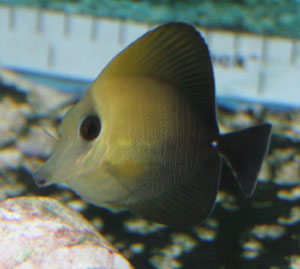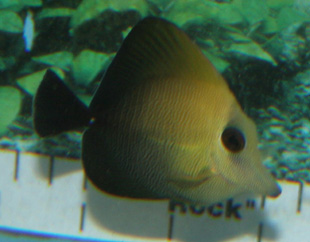Scopas Tang – Zebrasoma scopas
The scopas tang, also called the brown tang, comes from the Central and South Pacific Ocean region. The scopas does well in an aquarium that has plenty of active and healthy live rock with micro-algae and macro-algae to eat. This tang grows to only 8 inches and generally makes a good reef tank fish.
Maximum Size: The scopas tang should grow to a maximum size of 8.0 inches
Minimum Tank Size: The minimum tank size should be 75 gallons.
Care Level: The scopas tang is a pretty hardy fish to maintain. On a scale of 1 –10, (10 being easy) it would rate a “7”. The tank should already be cycled before introducing this fish. The scopas needs a diet rich in vegetable matter otherwise it may develop head and lateral line erosion.
Tank Conditions: Temperature 77-79°F; Specific gravity: 1.021 – 1.024; pH: 8.1 – 8.3; Nitrates should be no more than 20 ppm.
Color: The scopas tang – as picture shows is brown with a muted yellow sunburst behind its eyes up to its dorsal fin. The majority of the fish is brownish hues.
Temperament: This is a good fish. It can ultimately become aggressive to other tangs of its kind. You can maintain more than one but you will need to increase the tank size so each has room
Reef Compatible: Will eat micro-algae and macro-algae and browse on live rock. If you find it nipping at coral (both hard and soft) increase feeding amount. It is generally a safe reef fish.
 Diet: The scopas tang is basically an omnivore but will eat more vegetable matter. Feed dried and frozen marine algae along with sushi seaweed. You can even supplement its commercial diet with land vegetables such as zucchini and lettuce. Diet: The scopas tang is basically an omnivore but will eat more vegetable matter. Feed dried and frozen marine algae along with sushi seaweed. You can even supplement its commercial diet with land vegetables such as zucchini and lettuce.
Habitat: Provide with plenty of hiding places. Good water circulation is important as well as high quality water maintenance. Filtration should include a protein skimmer and activated carbon filtration.
Lighting: A high quality full spectrum lighting system should be used to help micro-algae and macro-algae grow.
Compatibility: Tang in general can be kept with, catfish, filefish, firefish, gobies, grammas, rabbitfish to name a few and they should not be housed with groupers, sharks, lionfish or rays and can be a problem if housed with damselfish, butterflyfish, cardinalfish and triggerfish.
|



 Diet: The scopas tang is basically an omnivore but will eat more vegetable matter. Feed dried and frozen marine algae along with sushi seaweed. You can even supplement its commercial diet with land vegetables such as zucchini and lettuce.
Diet: The scopas tang is basically an omnivore but will eat more vegetable matter. Feed dried and frozen marine algae along with sushi seaweed. You can even supplement its commercial diet with land vegetables such as zucchini and lettuce.